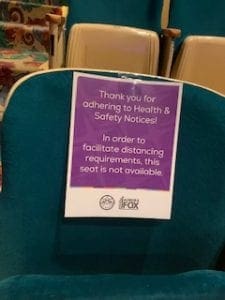TOMFOOLERY at the Aurora Fox Center
I went out in public. Yes, all the way outside of my house, to a public event, where there were strangers that I did not know, and I sat in a row of seats and watched these unfamiliar humans who, and I am not making this up, were in the same exact room as me. The event was Tomfoolery, a revue of the works of Tom Lehrer, at the Aurora Fox Arts Center, directed by Kenny Moten and executive produced by Helen Murray. I’ve seen a number of other productions at the Fox and never been disappointed so I was curious to see how this creative company would handle a pandemic-age production.
 The Colorado state government has issued guidelines for safety and the prevention of COVID-19 and the Fox appears to have followed all of them. Their website offers the details of their health and safety plan, including a 28-page document with full details of their campus’s reopening strategy, which is 28 pages more than the federal government has managed to produce. It seems to be a thoughtful and effective endeavor, although the total effect is a bit eerie and strange. But then, this entire year is eerie and strange. When attending previous productions at the Fox, the lobby has been crowded and the place hums with pre-show energy. Now, with the concession stand closed (the manager informed me to “have my drinks before I arrive”), 25% seating capacity, plastic barriers erected…it’s a different feeling. My escort and I snapped our mask elastics behind our ears, wrote our names and phone numbers in the contact tracing log, did the touchless ticket check-in, received a highlighted route map to our socially-distant seats, picked up the single-use playbills, and walked down the one-way hallway to our seats. The theater was, it almost goes without saying, three-quarters empty. Lights down, curtain up.
The Colorado state government has issued guidelines for safety and the prevention of COVID-19 and the Fox appears to have followed all of them. Their website offers the details of their health and safety plan, including a 28-page document with full details of their campus’s reopening strategy, which is 28 pages more than the federal government has managed to produce. It seems to be a thoughtful and effective endeavor, although the total effect is a bit eerie and strange. But then, this entire year is eerie and strange. When attending previous productions at the Fox, the lobby has been crowded and the place hums with pre-show energy. Now, with the concession stand closed (the manager informed me to “have my drinks before I arrive”), 25% seating capacity, plastic barriers erected…it’s a different feeling. My escort and I snapped our mask elastics behind our ears, wrote our names and phone numbers in the contact tracing log, did the touchless ticket check-in, received a highlighted route map to our socially-distant seats, picked up the single-use playbills, and walked down the one-way hallway to our seats. The theater was, it almost goes without saying, three-quarters empty. Lights down, curtain up.
Tom Lehrer is a mathematician and musical satirist whose arguably most-famous work is a ditty called “Poisoning Pigeons in the Park.” While his career is  definitely a work of its time–he got started selling his albums by mail-order via letters with postage stamps–the production has staged the revue in our very-specific current moment. The stage set was four cubes that surely must have been intended to mimic a Zoom room. The time was now. The event was Quarantine. The players were four characters (student (Moses Brown), nurse (Corey Exline), writer (Valerie Igoe), “bookworm” (Tim Howard)) all managing isolation, boredom and panic in their own way, in their own sweatpants. (The nurse surviving on box wine and a wand vibrator was a little *too* close to home, thank you.) The characters did not speak amongst themselves or to the audience–narration and transitions were provided by a voiceover (a gravelly Beau Bisson)–they just sang, which is uphill work through a mask. The masked songs were a bit muffled, just like all interpersonal exchanges these days. The performers did sing most of the numbers unmasked, a safe 25+ feet from the audience. Blocking tape on the stage deck (little marks, usually negligible to the audience, that guide the performers to their assigned spots) has been part of stage productions since forever, but it took on a bittersweet edge because we all now obey the blocking tape and signage pasted onto sidewalks and flooring. We hit our social-distancing marks and say our mask-muffled lines, just like the actors.
definitely a work of its time–he got started selling his albums by mail-order via letters with postage stamps–the production has staged the revue in our very-specific current moment. The stage set was four cubes that surely must have been intended to mimic a Zoom room. The time was now. The event was Quarantine. The players were four characters (student (Moses Brown), nurse (Corey Exline), writer (Valerie Igoe), “bookworm” (Tim Howard)) all managing isolation, boredom and panic in their own way, in their own sweatpants. (The nurse surviving on box wine and a wand vibrator was a little *too* close to home, thank you.) The characters did not speak amongst themselves or to the audience–narration and transitions were provided by a voiceover (a gravelly Beau Bisson)–they just sang, which is uphill work through a mask. The masked songs were a bit muffled, just like all interpersonal exchanges these days. The performers did sing most of the numbers unmasked, a safe 25+ feet from the audience. Blocking tape on the stage deck (little marks, usually negligible to the audience, that guide the performers to their assigned spots) has been part of stage productions since forever, but it took on a bittersweet edge because we all now obey the blocking tape and signage pasted onto sidewalks and flooring. We hit our social-distancing marks and say our mask-muffled lines, just like the actors.
Being out at a live performance again was…wonderful. Getting dressed, I honestly had trouble recalling what was appropriate to wear “out” and I found that my eyeliner, unused since…March, had mummified. The actors seems to be as thrilled to be back on stage as I was to be in the audience. All four gave delightful vocal performances and fun physicality to the limited space of their quarantine cubes. I’ll call out Moses Brown (The Student) as a particularly charming performance. They sang with verve and enthusiasm, and, despite someone having coached them into a brief rendition of the Macarena, they seem to bear no ill-will toward their choreographer.
Lehrer’s songbook got a couple of minor updates (lyrics included references to Netflix, homoerotic allusions, etc.), which was probably necessary, since, as we said, it’s a product of a different time. Overall though, it seemed to fit hand-in-nitrile-glove with our current moment. We were threatened by pollution and social divisions fifty years ago; we are today. We worried about STI’s fifty years ago; we still do today. Silly songs are still joyful and sheer displays of lyrical cleverness are still delightful. I loved Brown’s “The Elements,” but I didn’t care a lot for Exline’s “The Irish Ballad.” While she sang it skillfully, the song itself seemed redundant in that it was mocking silly song repetitions while being itself a song of silly repetitions. Why does Lehrer make us to listen to a genre that he doesn’t like? Lehrer also wrote music for the Electric Company and Valerie Igoe, who appeared to be about my own age, singing “Silent E” hit me with a wave of nostalgia and reminded me of how evocative the sounds of our childhoods are and how they stay with us through our lives. Tim Howard sang about the horror and silliness of war in a way that rang just as true today as it did during the Vietnam era.
The entire production is a product of *this* time. It’s been a terrifying and fascinating year; watching artists adapt and create has been the fascinating part. It felt so, so strange to leave my house and go out in public for gratuitous purposes. It felt emotionally overwhelming to sit in a room with other people. (I no-joking nearly cried just from that.) As I watched the people who have the courage and endurance to make new art and joyfully perform it, I realized that this isn’t gratuitous at all. We need art and connection just as much as we need masks and ventilators. We each have to make our own educated choices about what risks to assume and we all need to follow the guidelines so that our choices don’t endanger others. But if you’re willing to assume the well-managed risk (28 pages!), Tomfoolery was a breath of air.



















